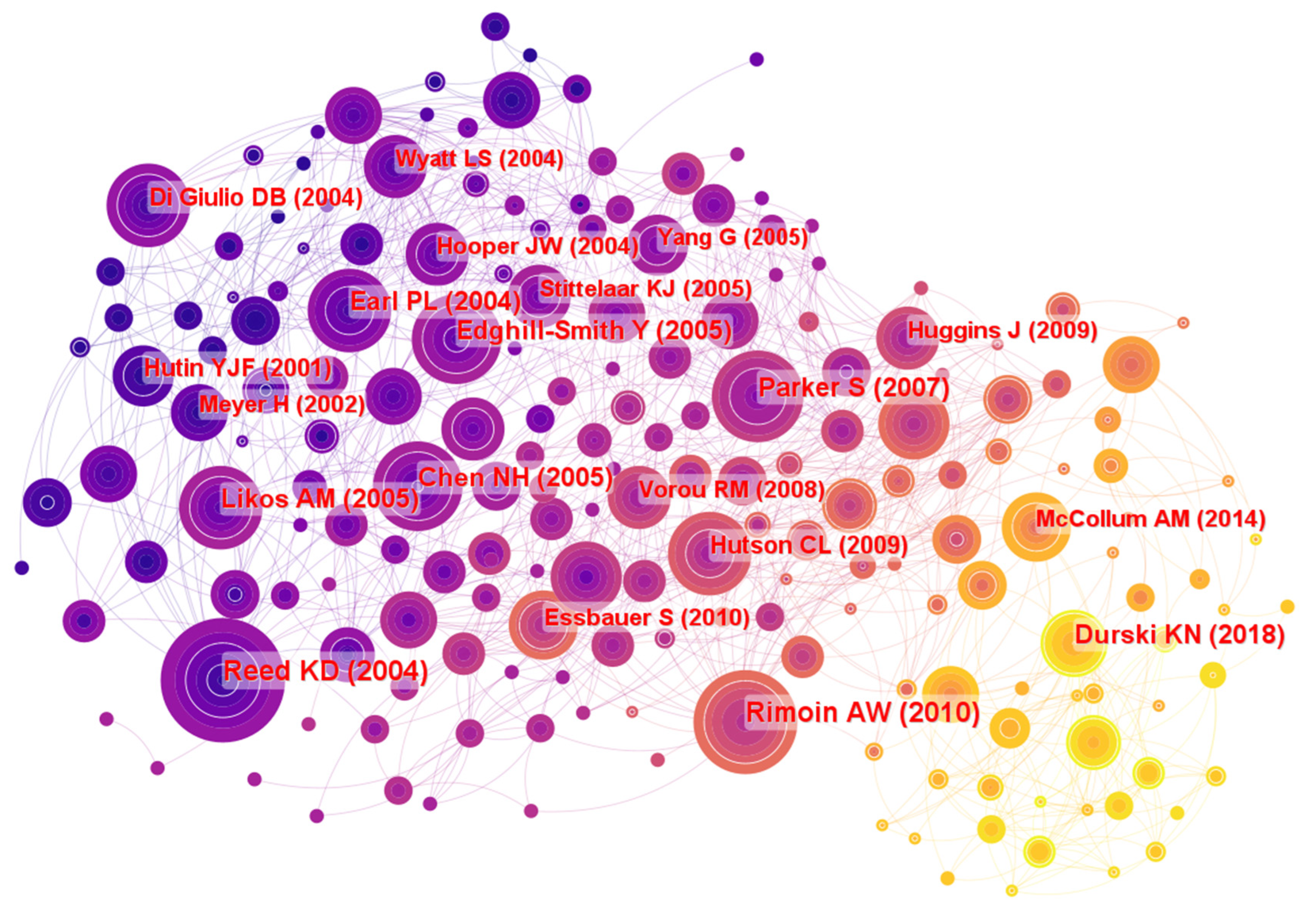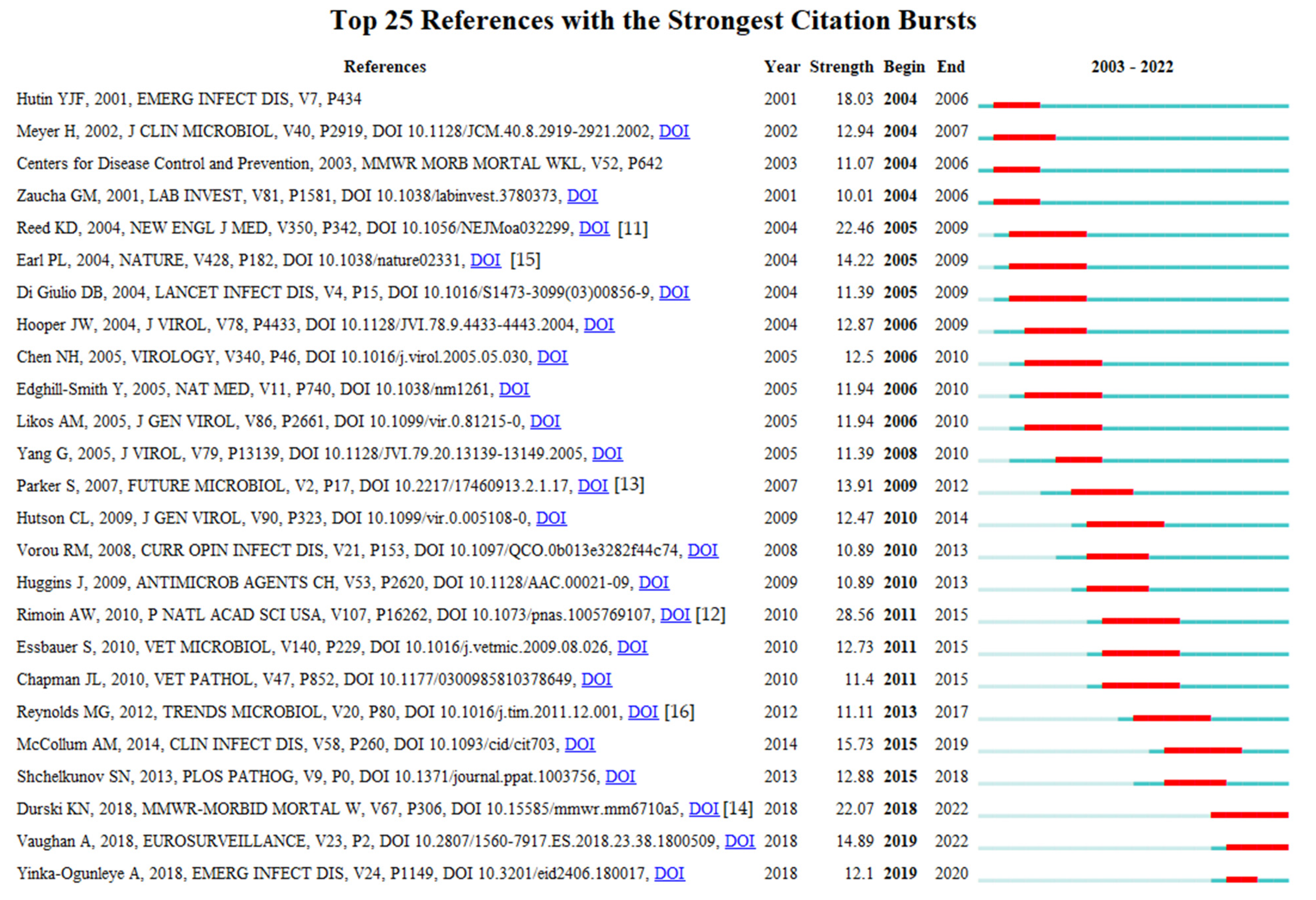Bibliometric Analysis and Key Messages of Monkeypox Research (2003–2022)
Abstract
1. Introduction
2. Methods
2.1. Search Strategies
2.2. Data Collection and Analysis
2.3. Materials and Methods
3. Results
3.1. Publication Output and Temporal Trend
3.2. Distribution by Country/Region
3.3. Distribution by Author
3.4. Distribution by Journal and Analysis of Co-Cited References
3.5. Analysis of Keywords Co-Occurrence Clusters
3.6. Analysis of Burst Keywords
4. Discussion
5. Limitation
6. Conclusions
Author Contributions
Funding
Institutional Review Board Statement
Informed Consent Statement
Data Availability Statement
Conflicts of Interest
References
- Bragazzi, N.L.; Kong, J.D.; Mahroum, N.; Tsigalou, C.; Khamisy-Farah, R.; Converti, M.; Wu, J. Epidemiological trends and clinical features of the ongoing monkeypox epidemic: A preliminary pooled data analysis and literature review. J. Med. Virol. 2023, 95, e27931. [Google Scholar] [CrossRef] [PubMed]
- Antinori, A.; Mazzotta, V.; Vita, S.; Carletti, F.; Tacconi, D.; Lapini, L.E.; D’Abramo, A.; Cicalini, S.; Lapa, D.; Pittalis, S.; et al. Epidemiological, clinical and virological characteristics of four cases of monkeypox support transmission through sexual contact, Italy, May 2022. Eurosurveillance 2022, 27, 2200421. [Google Scholar] [CrossRef]
- Vivancos, R.; Anderson, C.; Blomquist, P.; Balasegaram, S.; Bell, A.; Bishop, L.; Brown, C.; Chow, Y.; Edeghere, O.; Florence, I.; et al. Community transmission of monkeypox in the United Kingdom, April to May 2022. Eurosurveillance 2022, 27, 2200422. [Google Scholar] [CrossRef]
- Adegboye, O.A.; Castellanos, M.E.; Alele, F.O.; Pak, A.; Ezechukwu, H.C.; Hou, K.; Emeto, T.I. Travel-Related Monkeypox Outbreaks in the Era of COVID-19 Pandemic: Are We Prepared? Viruses 2022, 14, 1283. [Google Scholar] [CrossRef] [PubMed]
- Mauldin, M.; McCollum, A.; Nakazawa, Y.; Mandra, A.; Whitehouse, E.; Davidson, W.; Zhao, H.; Gao, J.; Li, Y.; Doty, J.; et al. Exportation of Monkeypox Virus from the African Continent. J. Infect. Dis. 2022, 225, 1367–1376. [Google Scholar] [CrossRef] [PubMed]
- Saxena, S.K.; Ansari, S.; Maurya, V.K.; Kumar, S.; Jain, A.; Paweska, J.T.; Tripathi, A.K.; Abdel-Moneim, A.S. Re-emerging human monkeypox: A major public-health debacle. J. Med. Virol. 2023, 95, e27902. [Google Scholar] [CrossRef]
- Yang, Z. Monkeypox: A potential global threat? J. Med. Virol. 2022, 94, 4034–4036. [Google Scholar] [CrossRef]
- Benita, F. Human mobility behavior in COVID-19: A systematic literature review and bibliometric analysis. Sustain. Cities Soc. 2021, 70, 102916. [Google Scholar] [CrossRef]
- Zyoud, S.H. The Arab region’s contribution to global COVID-19 research: Bibliometric and visualization analysis. Glob. Health 2021, 17, 31. [Google Scholar] [CrossRef]
- Fan, J.; Gao, Y.; Zhao, N.; Dai, R.; Zhang, H.; Feng, X.; Shi, G.; Tian, J.; Chen, C.; Hambly, B.; et al. Bibliometric Analysis on COVID-19: A Comparison of Research between English and Chinese Studies. Front. Public Health 2020, 8, 477. [Google Scholar] [CrossRef]
- Reed, K.D.; Melski, J.W.; Graham, M.B.; Regnery, R.L.; Sotir, M.J.; Wegner, M.V.; Kazmierczak, J.J.; Stratman, E.J.; Li, Y.; Fairley, J.A.; et al. The detection of monkeypox in humans in the Western Hemisphere. N. Engl. J. Med. 2004, 350, 342–350. [Google Scholar] [CrossRef] [PubMed]
- Rimoin, A.W.; Mulembakani, P.M.; Johnston, S.C.; Lloyd Smith, J.O.; Kisalu, N.K.; Kinkela, T.L.; Blumberg, S.; Thomassen, H.A.; Pike, B.L.; Fair, J.N.; et al. Major increase in human monkeypox incidence 30 years after smallpox vaccination campaigns cease in the Democratic Republic of Congo. Proc. Natl. Acad. Sci. USA 2010, 107, 16262–16267. [Google Scholar] [CrossRef] [PubMed]
- Parker, S.; Nuara, A.; Buller, R.M.L.; Schultz, D.A. Human monkeypox: An emerging zoonotic disease. Future Microbiol. 2007, 2, 17–34. [Google Scholar] [CrossRef] [PubMed]
- Durski, K.N.; McCollum, A.M.; Nakazawa, Y.; Petersen, B.W.; Reynolds, M.G.; Briand, S.; Djingarey, M.H.; Olson, V.; Damon, I.K.; Khalakdina, A. Emergence of Monkeypox—West and Central Africa, 1970–2017. Mmwr-Morb. Mortal. Wkly. Rep. 2018, 67, 306–310. [Google Scholar] [CrossRef]
- Earl, P.L.; Americo, J.L.; Wyatt, L.S.; Eller, L.A.; Whitbeck, J.C.; Cohen, G.H.; Eisenberg, R.J.; Hartmann, C.J.; Jackson, D.L.; Kulesh, D.A.; et al. Immunogenicity of a highly attenuated MVA smallpox vaccine and protection against monkeypox. Nature 2004, 428, 182–185. [Google Scholar] [CrossRef] [PubMed]
- Reynolds, M.G.; Carroll, D.S.; Karem, K.L. Factors affecting the likelihood of monkeypox’s emergence and spread in the post-smallpox era. Curr. Opin. Virol. 2012, 2, 335–343. [Google Scholar] [CrossRef] [PubMed]
- Weaver, J.R.; Isaacs, S.N. Monkeypox virus and insights into its immunomodulatory proteins. Immunol. Rev. 2008, 225, 96–113. [Google Scholar] [CrossRef] [PubMed]
- Nakazawa, Y.; Lash, R.R.; Carroll, D.S.; Damon, I.K.; Karem, K.L.; Reynolds, M.G.; Osorio, J.E.; Rocke, T.E.; Malekani, J.M.; Muyembe, J.-J.; et al. Mapping Monkeypox Transmission Risk through Time and Space in the Congo Basin. PLoS ONE 2013, 8, e74816. [Google Scholar] [CrossRef]
- Hughes, L.J.; Townsendl, M.B.; Gallardo-Romerol, N.; Hutson, C.L.; Patel, N.; Doty, J.B.; Salzer, J.S.; Damon, I.K.; Carroll, D.S.; Satheshkumar, P.S.; et al. Magnitude and diversity of immune response to vaccinia virus is dependent on route of administration. Virology 2020, 544, 55–63. [Google Scholar] [CrossRef]
- Nakazawa, Y.; Mauldin, M.R.; Emerson, G.L.; Reynolds, M.G.; Lash, R.R.; Gao, J.; Zhao, H.; Li, Y.; Muyembe, J.J.; Mbala Kingebeni, P.; et al. A Phylogeographic Investigation of African Monkeypox. Viruses 2015, 7, 2168–2184. [Google Scholar] [CrossRef]
- Rao, A.K.; Schulte, J.; Chen, T.H.; Hughes, C.M.; Davidson, W.; Neff, J.M.; Markarian, M.; Delea, K.C.; Wada, S.; Liddell, A.; et al. Monkeypox in a Traveler Returning from Nigeria—Dallas, Texas, July 2021. Mmwr-Morb. Mortal. Wkly. Rep. 2022, 71, 509–516. [Google Scholar] [CrossRef]
- Keckler, M.S.; Salzer, J.S.; Patel, N.; Townsend, M.B.; Nakazawa, Y.J.; Doty, J.B.; Gallardo-Romero, N.F.; Satheshkumar, P.S.; Carroll, D.S.; Karem, K.L.; et al. IMVAMUNE(R) and ACAM2000(R) Provide Different Protection against Disease When Administered Postexposure in an Intranasal Monkeypox Challenge Prairie Dog Model. Vaccines 2020, 8, 396. [Google Scholar] [CrossRef]
- Petersen, E.; Kantele, A.; Koopmans, M.; Asogun, D.; Yinka-Ogunleye, A.; Ihekweazu, C.; Zumla, A. Human Monkeypox Epidemiologic and Clinical Characteristics, Diagnosis, and Prevention. Infect. Dis. Clin. N. Am. 2019, 33, 1027. [Google Scholar] [CrossRef] [PubMed]
- Damon, I.K. Status of human monkeypox: Clinical disease, epidemiology and research. Vaccine 2011, 29, D54–D59. [Google Scholar] [CrossRef] [PubMed]
- Hutson, C.L.; Kondas, A.V.; Mauldin, M.R.; Doty, J.B.; Grossi, I.M.; Morgan, C.N.; Ostergaard, S.D.; Hughes, C.M.; Nakazawa, Y.; Kling, C.; et al. Pharmacokinetics and Efficacy of a Potential Smallpox Therapeutic, Brincidofovir, in a Lethal Monkeypox Virus Animal Model. Msphere 2021, 6, e00927-20. [Google Scholar] [CrossRef]
- Sergeev, A.A.; Kabanov, A.S.; Bulychev, L.E.; Sergeev, A.A.; Pyankov, O.V.; Bodnev, S.A.; Galahova, D.O.; Zamedyanskaya, A.S.; Titova, K.A.; Glotova, T.I.; et al. Using the Ground Squirrel (Marmota bobak) as an Animal Model to Assess Monkeypox Drug Efficacy. Transbound. Emerg. Dis. 2017, 64, 226–236. [Google Scholar] [CrossRef] [PubMed]
- Hutson, C.L.; Damon, I.K. Monkeypox Virus Infections in Small Animal Models for Evaluation of Anti-Poxvirus Agents. Viruses 2010, 2, 2763–2776. [Google Scholar] [CrossRef]
- Shchelkunov, S.N.; Totmenin, A.V.; Babkin, I.V.; Safronov, P.F.; Ryazankina, O.I.; Petrov, N.A.; Gutorov, V.V.; Uvarova, E.A.; Mikheev, M.V.; Sisler, J.R.; et al. Human monkeypox and smallpox viruses: Genomic comparison. FEBS Lett. 2001, 509, 66–70. [Google Scholar] [CrossRef]
- Abrahams, B.C.; Kaufman, D.M. Anticipating smallpox and monkeypox outbreaks—Complications of the smallpox vaccine. Neurologist 2004, 10, 265–274. [Google Scholar] [CrossRef]
- Parker, S.; D’Angelo, J.; Buller, R.M.; Smee, D.F.; Lantto, J.; Nielsen, H.; Jensen, A.; Prichard, M.; George, S.L. A human recombinant analogue to plasma-derived vaccinia immunoglobulin prophylactically and therapeutically protects against lethal orthopoxvirus challenge. Antivir. Res. 2021, 195, 105179. [Google Scholar] [CrossRef]
- Smith, S.K.; Self, J.; Weiss, S.; Carroll, D.; Braden, Z.; Regnery, R.L.; Davidson, W.; Jordan, R.; Hruby, D.E.; Damon, I.K. Effective Antiviral Treatment of Systemic Orthopoxvirus Disease: ST-246 Treatment of Prairie Dogs Infected with Monkeypox Virus. J. Virol. 2011, 85, 9176–9187. [Google Scholar] [CrossRef] [PubMed]
- Smith, S.K.; Olson, V.A.; Karem, K.L.; Jordan, R.; Hruby, D.E.; Damon, I.K. In Vitro Efficacy of ST246 against Smallpox and Monkeypox. Antimicrob. Agents Chemother. 2009, 53, 1007–1012. [Google Scholar] [CrossRef] [PubMed]
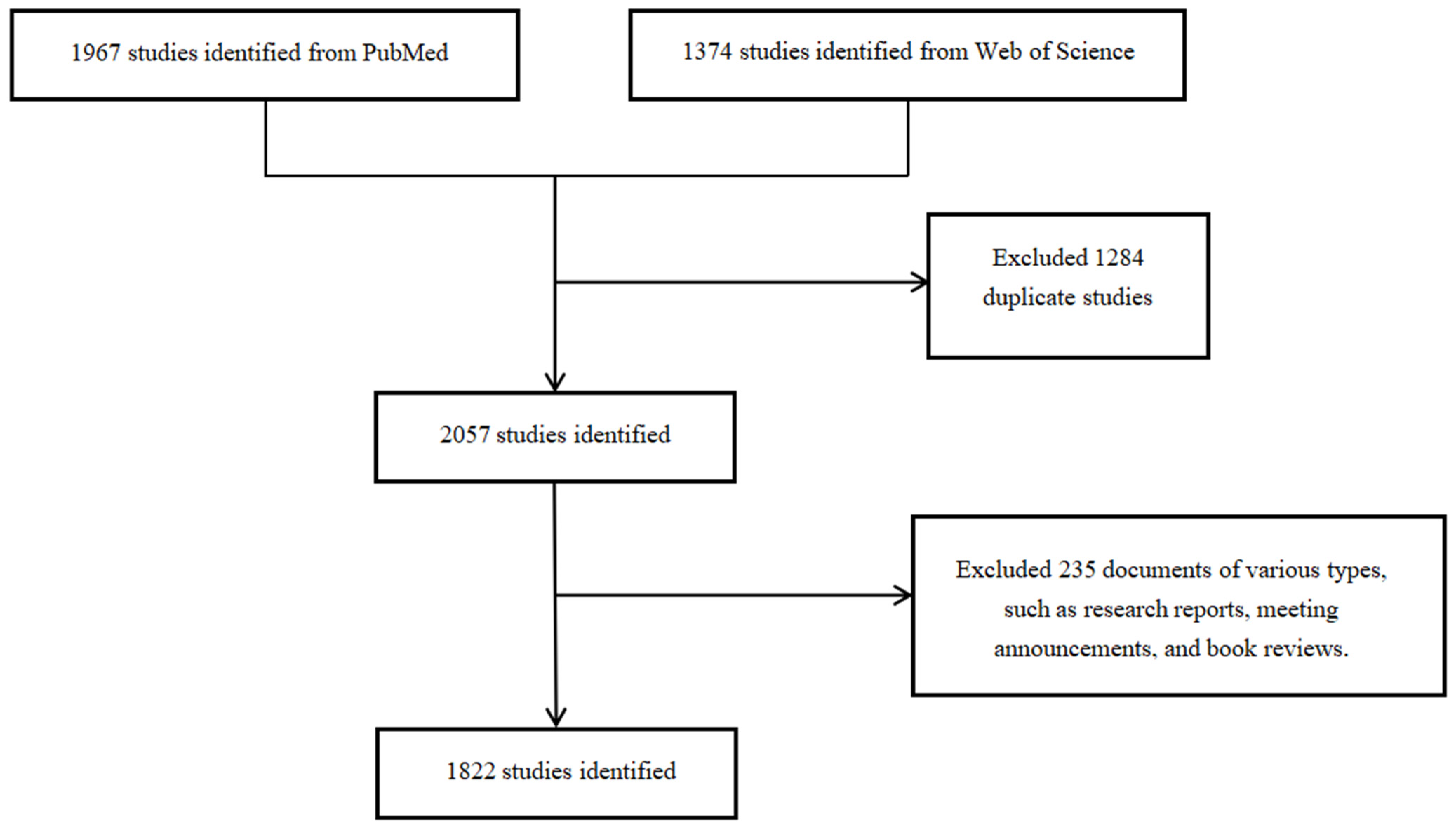
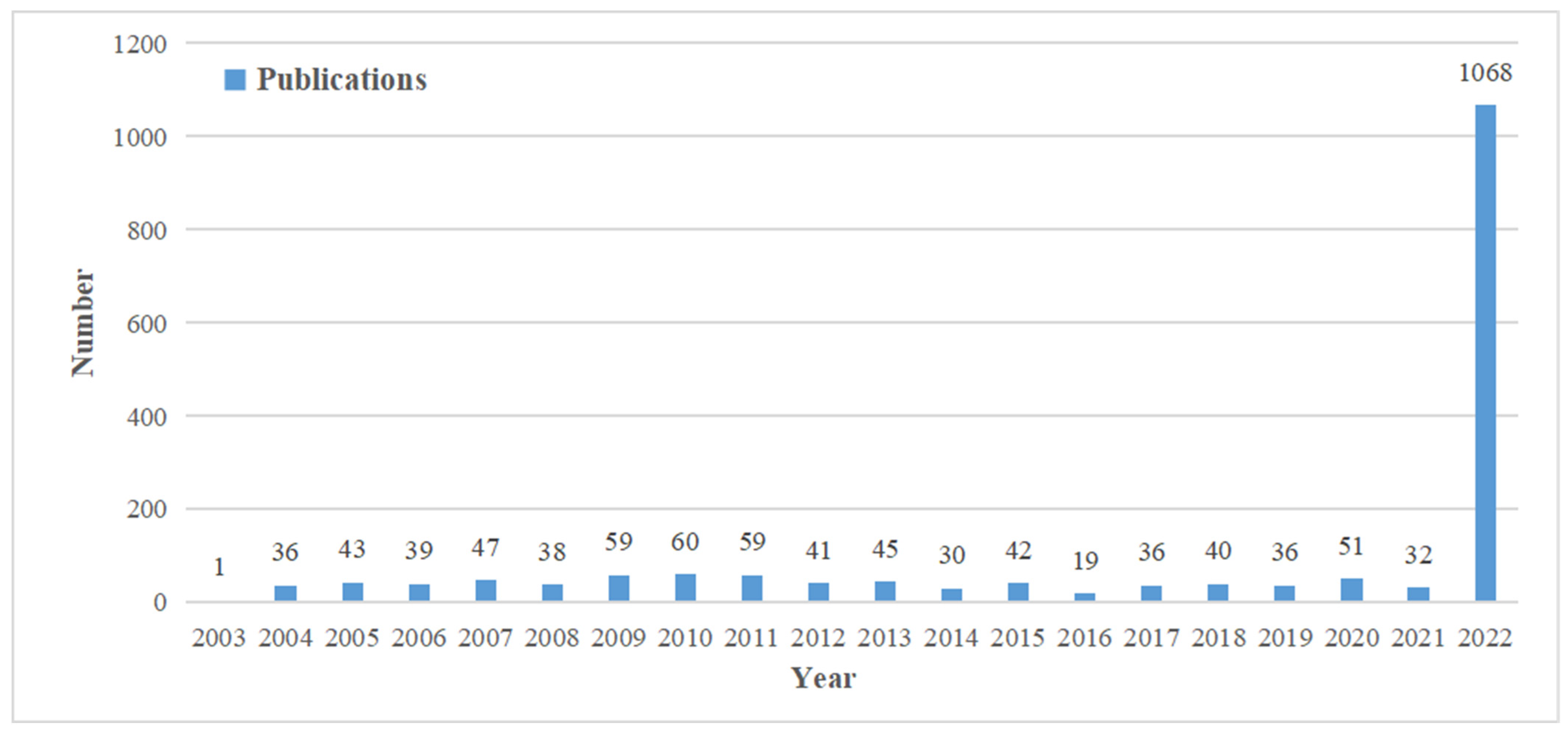

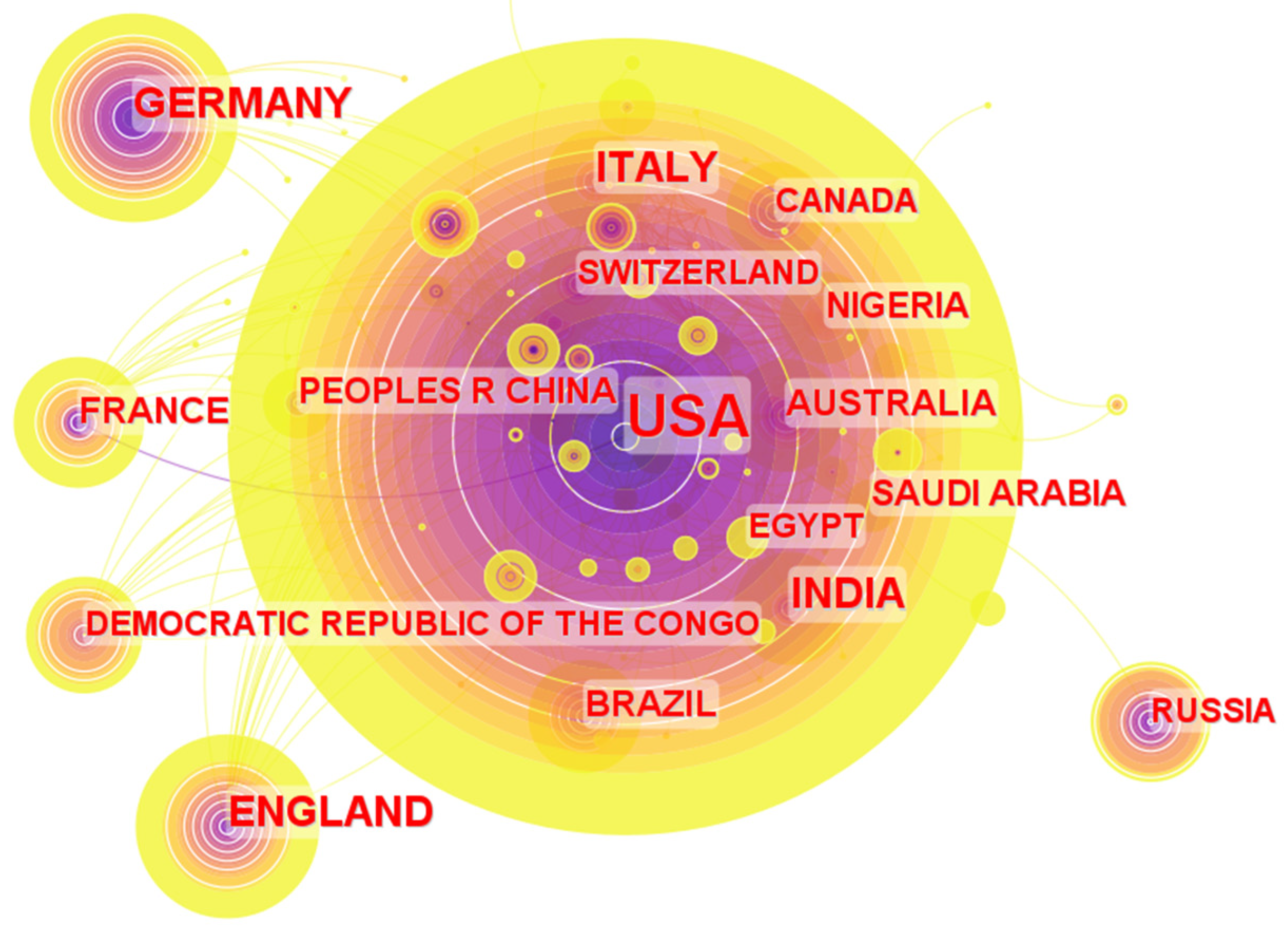
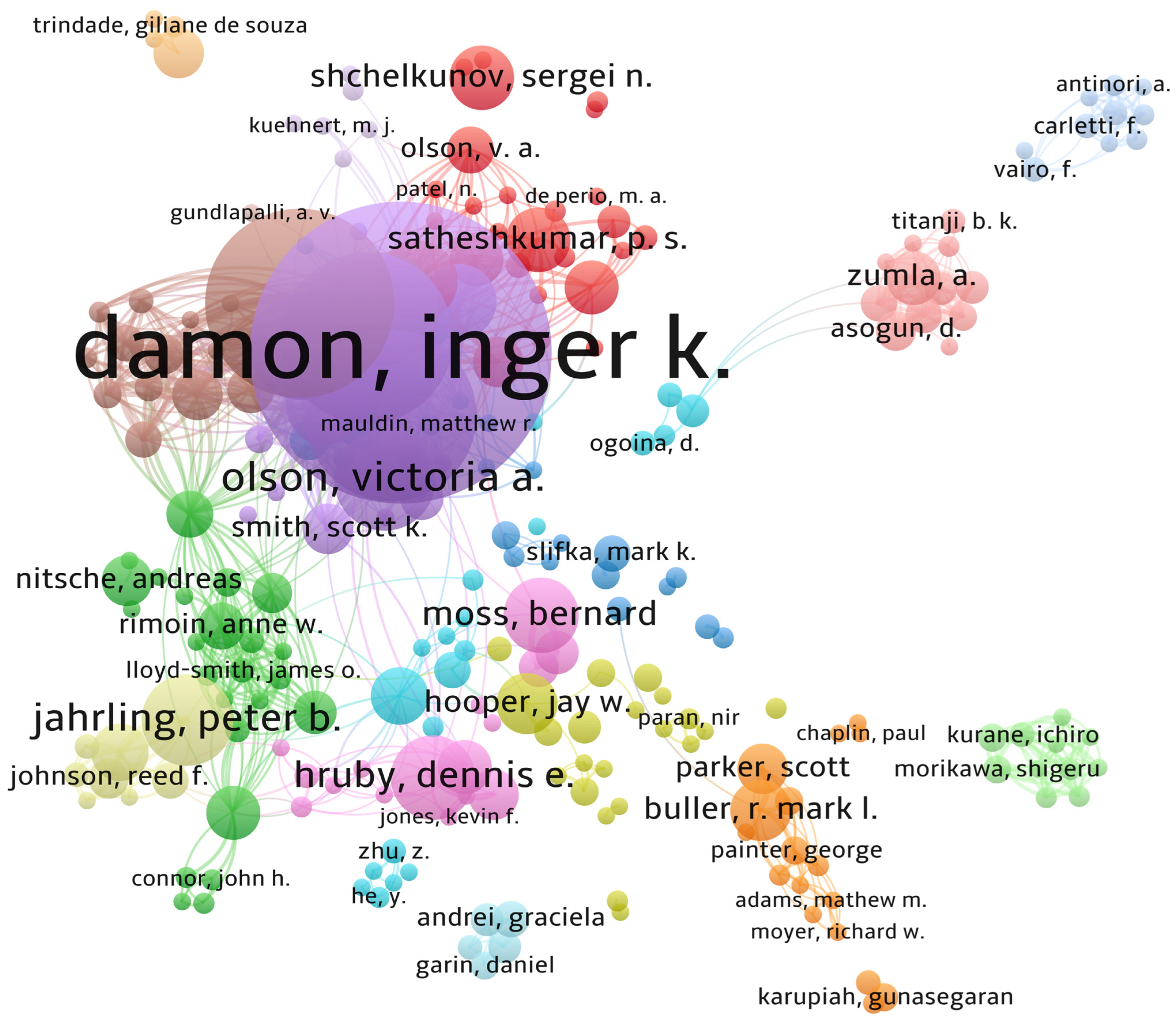
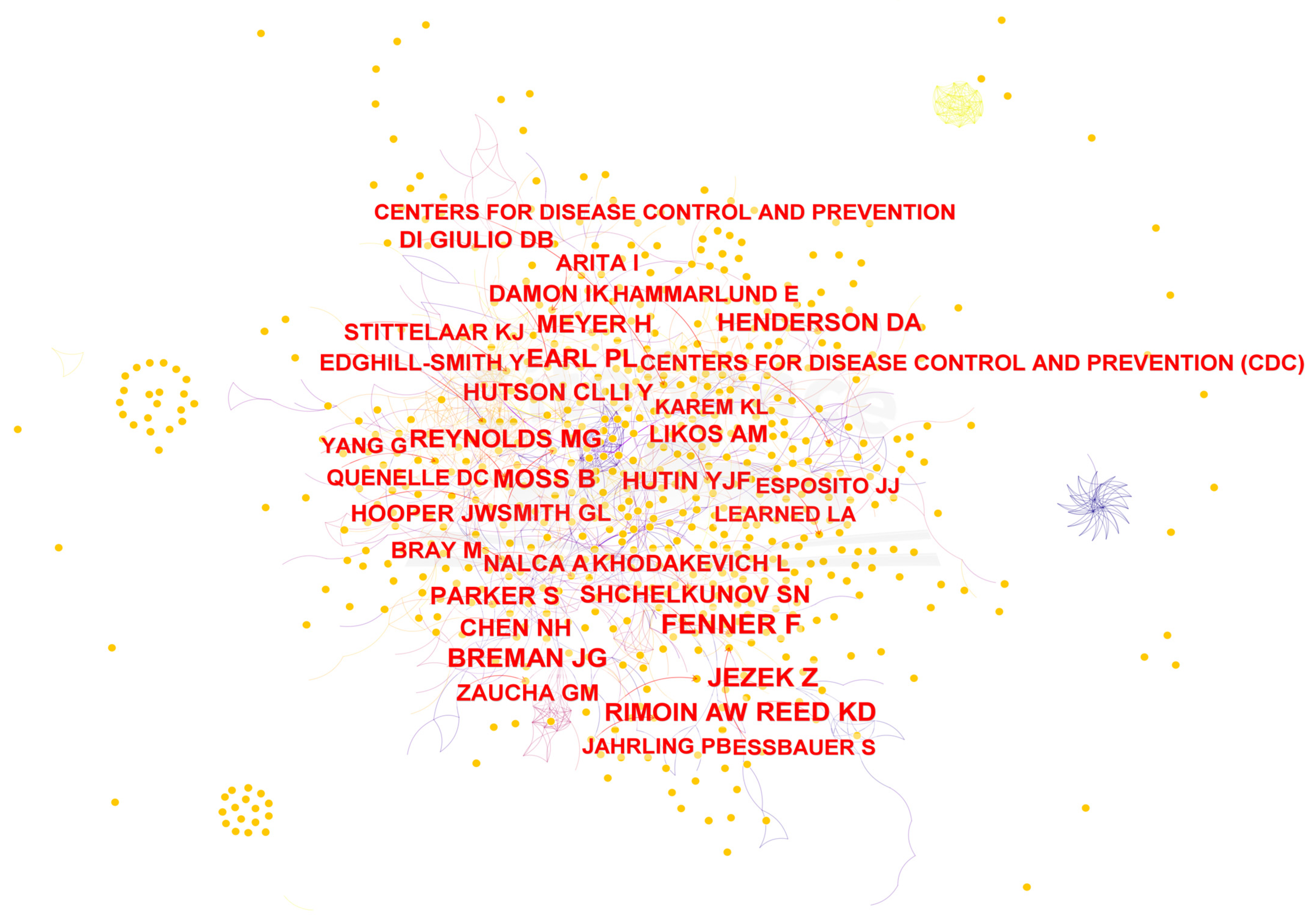
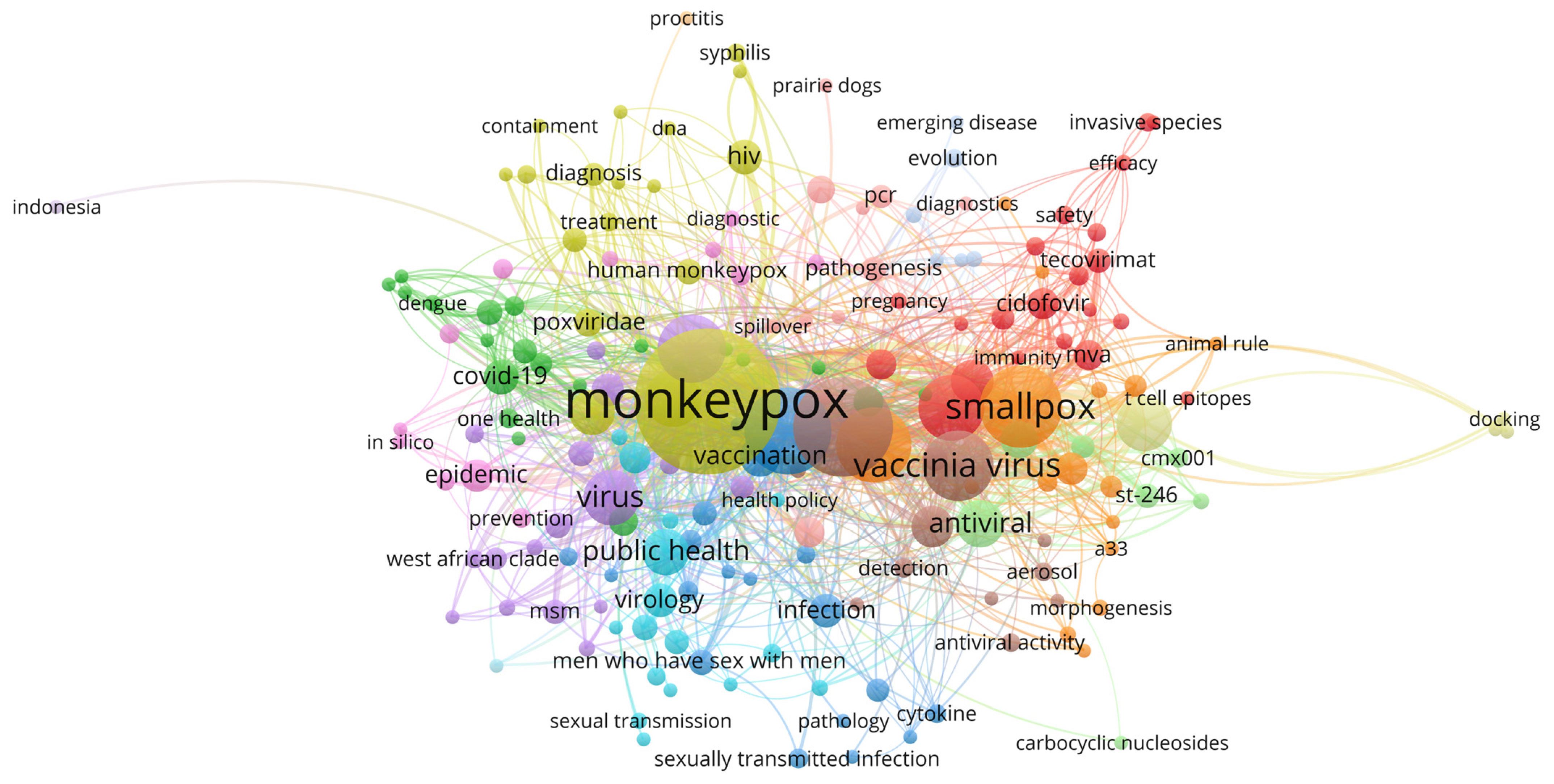
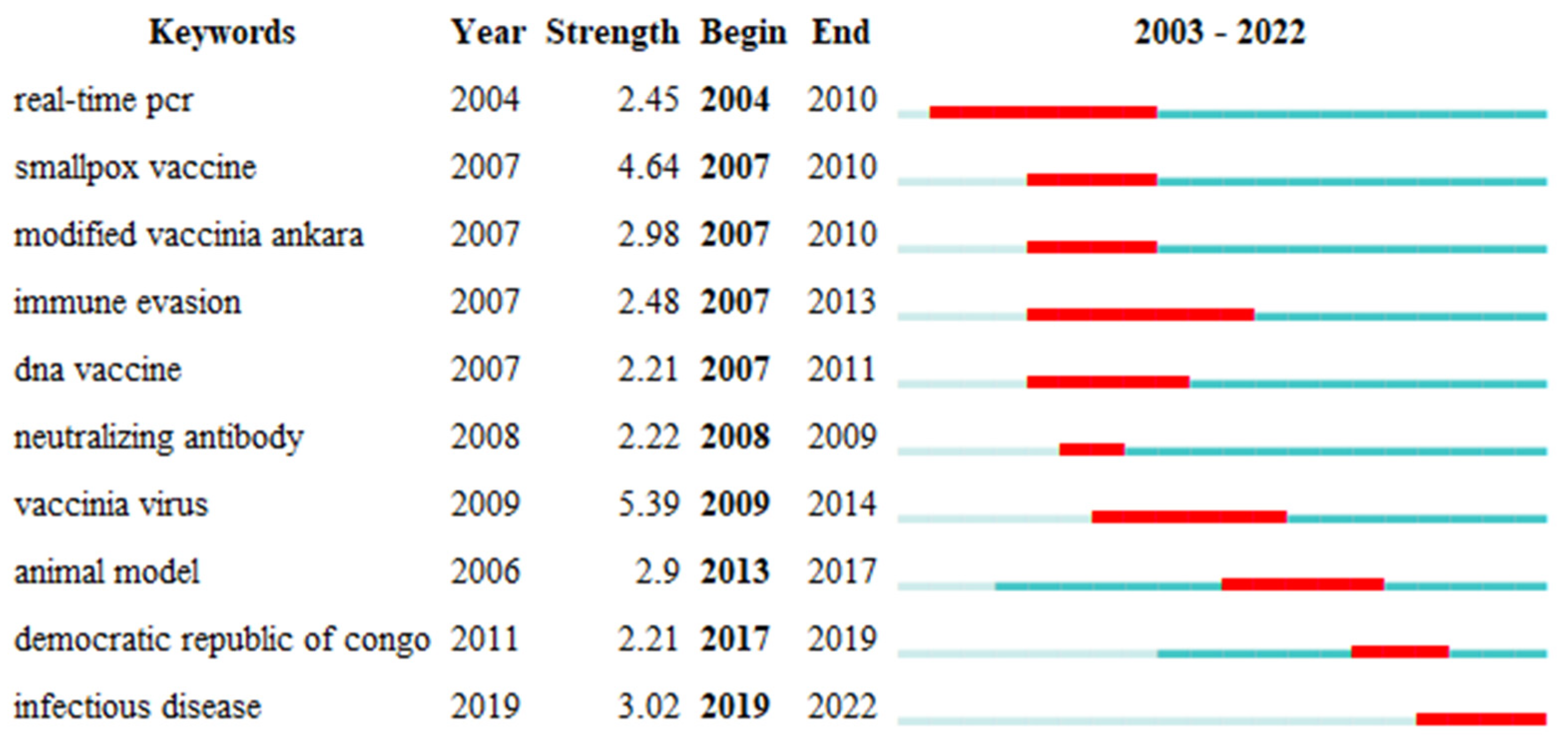
| Number | Author | Documents | Total Link Strength | Country | Institution/Organization |
|---|---|---|---|---|---|
| 1st | Damon, IK | 94 | 481 | USA | Centers for Disease Control and Prevention—USA |
| 2nd | Reynolds, MG | 56 | 333 | USA | Centers for Disease Control and Prevention—USA |
| 3rd | Carroll, DS | 50 | 338 | USA | Centers for Disease Control and Prevention—USA |
| 4th | Karem, KL | 50 | 297 | USA | Centers for Disease Control and Prevention—USA |
| 5th | Mccollum, A | 32 | 212 | USA | Centers for Disease Control and Prevention—USA |
| 6th | Li, Y | 30 | 209 | USA | Centers for Disease Control and Prevention—USA |
| 7th | Olson, VA | 28 | 178 | USA | Centers for Disease Control and Prevention—USA |
| 8th | Jahrling, PB | 25 | 61 | USA | NIH National Institute of Allergy and Infectious Diseases |
| 9th | Hruby, DE | 23 | 64 | USA | SIGA Technol Inc |
| 10th | Nakazawa, YJ | 23 | 171 | USA | Centers for Disease Control and Prevention—USA |
| Number | Count | Centrality | Year | Cited Authors | Country | Institution/Organization |
|---|---|---|---|---|---|---|
| 1st | 14 | 0.26 | 2004 | Buller, RML | USA | Saint Louis University |
| 2nd | 24 | 0.22 | 2011 | Abrahao, JS | Brazil | Universidade Federal de Minas Gerais |
| 3rd | 18 | 0.16 | 2017 | Bera, BC | INDIA | ICAR—National Research Centre on Equine |
| 4th | 12 | 0.14 | 2008 | Jordan, R | USA | Gilead Sciences |
| 5th | 12 | 0.13 | 2006 | Fogg, C | USA | 2013-2018 Freelance Sci Writer |
| 6th | 6 | 0.13 | 2008 | Broyles, SS | USA | Purdue University |
| 7th | 9 | 0.12 | 2009 | Berhanu, A | Ethiopia | CDC Ethiopia |
| 8th | 17 | 0.11 | 2005 | Senkevich, TG | USA | National Institutes of Health (NIH)—USA |
| 9th | 11 | 0.11 | 2005 | Wyatt, LS | USA | National Institutes of Health (NIH)—USA |
| 10th | 10 | 0.11 | 2004 | Damaso, CR | Brazil | Universidade Federal do Rio de Janeiro |
| Number | Journal | Documents | Country | Journal Rank |
|---|---|---|---|---|
| 1st | J VIROL | 482 | Netherlands | Q2 |
| 2nd | VIROLOGY | 442 | USA | Q3 |
| 3rd | P NATL ACAD SCI USA | 432 | USA | Q1 |
| 4th | EMERG INFECT DIS | 425 | USA | Q1 |
| 5th | J GEN VIROL | 409 | England | Q2 |
| 6th | NEW ENGL J MED | 379 | USA | Q1 |
| 7th | J INFECT DIS | 374 | UK | Q1 |
| 8th | CLIN INFECT DIS | 311 | UK | Q1 |
| 9th | NATURE | 288 | UK | Q1 |
| 10th | AM J TROP MED HYG | 282 | USA | Q2 |
| Number | Keyword | Occurrences | Total Link Strength |
|---|---|---|---|
| 1st | monkeypox | 128 | 245 |
| 2nd | orthopoxvirus | 107 | 230 |
| 3rd | smallpox | 73 | 193 |
| 4th | vaccinia virus | 69 | 133 |
| 5th | poxvirus | 56 | 114 |
| 6th | monkeypox virus | 45 | 85 |
| 7th | variola | 44 | 136 |
| 8th | zoonosis | 42 | 91 |
| 9th | vaccinia | 34 | 98 |
| 10th | antiviral | 28 | 73 |
| 11th | smallpox vaccine | 24 | 45 |
| 12th | vaccine | 23 | 54 |
| 13th | cowpox virus | 22 | 58 |
| 14th | animal model | 20 | 60 |
| 15th | epidemiology | 16 | 45 |
| 16th | virus | 16 | 49 |
| 17th | cowpox | 15 | 52 |
| 18th | bioterrorism | 13 | 26 |
| 19th | cidofovir | 13 | 38 |
| 20th | outbreak | 13 | 31 |
Disclaimer/Publisher’s Note: The statements, opinions and data contained in all publications are solely those of the individual author(s) and contributor(s) and not of MDPI and/or the editor(s). MDPI and/or the editor(s) disclaim responsibility for any injury to people or property resulting from any ideas, methods, instructions or products referred to in the content. |
© 2023 by the authors. Licensee MDPI, Basel, Switzerland. This article is an open access article distributed under the terms and conditions of the Creative Commons Attribution (CC BY) license (https://creativecommons.org/licenses/by/4.0/).
Share and Cite
Yu, W.; Zhang, X.; Du, M.; Dong, Y.; Liu, L.; Rong, H.; Liu, J. Bibliometric Analysis and Key Messages of Monkeypox Research (2003–2022). Sustainability 2023, 15, 1005. https://doi.org/10.3390/su15021005
Yu W, Zhang X, Du M, Dong Y, Liu L, Rong H, Liu J. Bibliometric Analysis and Key Messages of Monkeypox Research (2003–2022). Sustainability. 2023; 15(2):1005. https://doi.org/10.3390/su15021005
Chicago/Turabian StyleYu, Weijie, Xiaowen Zhang, Meijiao Du, Yue Dong, Lin Liu, Hongguo Rong, and Jianping Liu. 2023. "Bibliometric Analysis and Key Messages of Monkeypox Research (2003–2022)" Sustainability 15, no. 2: 1005. https://doi.org/10.3390/su15021005
APA StyleYu, W., Zhang, X., Du, M., Dong, Y., Liu, L., Rong, H., & Liu, J. (2023). Bibliometric Analysis and Key Messages of Monkeypox Research (2003–2022). Sustainability, 15(2), 1005. https://doi.org/10.3390/su15021005




